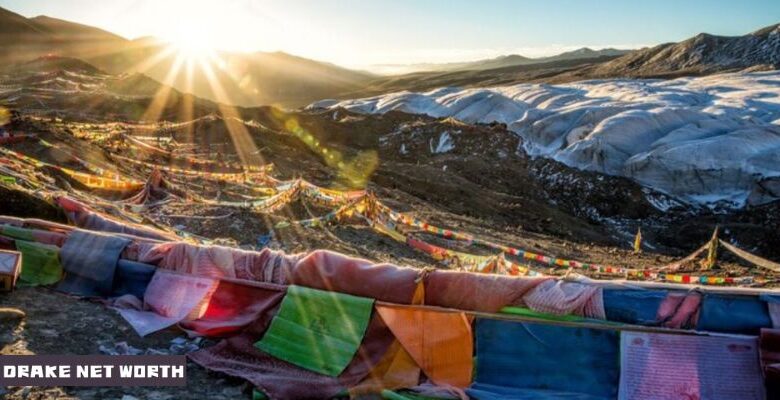Discovering the Himalayan Resting Place: A Comprehensive Guide

The Himalayan Resting Place, nestled in the heart of the majestic Himalayas, captivates travelers with its serene and spiritual ambiance. This hidden gem, renowned for its breathtaking landscapes and rich cultural heritage, offers a tranquil escape from the hustle and bustle of daily life. Visitors are drawn to its peaceful environment, seeking solace and a deep connection with nature.
Exploring the Himalayan Resting Place reveals a multitude of experiences, from hiking through lush forests to meditating in ancient monasteries. Whether you’re an adventure enthusiast or someone looking to reconnect with spirituality, this destination has something for everyone. The unique blend of natural beauty and cultural richness creates an unforgettable experience.
To uncover the secrets of this enchanting place and learn how to make the most of your visit, read on. This comprehensive guide will provide detailed insights into the history, geography, activities, and practical tips to help you plan an extraordinary journey to the Himalayan Resting Place.
History and Sgnificance
Historical Background
The Himalayan Resting Place has a rich history that dates back centuries. It has been a site of spiritual significance for various cultures and religions. Ancient texts and folklore speak of its mystical powers and its role as a sanctuary for monks and sages. The region’s history is intertwined with legends and myths that add to its allure.
Cultural and Spiritual Importance
The cultural and spiritual importance of the Himalayan Resting Place cannot be overstated. It is considered a sacred site by many, attracting pilgrims from across the globe. The area is dotted with monasteries, temples, and shrines, each with its own story and significance. The spiritual energy here is palpable, making it a perfect destination for those seeking inner peace and enlightenment.
Notable Events and Figures
Over the years, the Himalayan Resting Place has witnessed numerous notable events and has been graced by the presence of many influential figures. From historical battles to spiritual gatherings, the place has a vibrant history. Prominent spiritual leaders and explorers have left their mark here, contributing to its rich tapestry of stories.
Geographical Overview
Location and Accessibility
The Himalayan Resting Place is located in the northern part of the Himalayas, spanning across several countries including India, Nepal, and Bhutan. Despite its remote location, it is accessible through various modes of transport. Visitors can reach the nearest towns by air, rail, or road and then embark on a scenic journey to the resting place.
Surrounding Environment and Landscapes
The surrounding environment of the Himalayan Resting Place is characterized by towering peaks, lush valleys, and pristine rivers. The landscapes are diverse, ranging from dense forests to alpine meadows. This natural beauty provides a stunning backdrop for visitors and offers countless opportunities for exploration and adventure.
Climate and Best Times to Visit
The climate in the Himalayan Resting Place varies significantly with altitude and season. Summers are pleasant with clear skies, making it ideal for trekking and sightseeing. Winters can be harsh with heavy snowfall, transforming the region into a winter wonderland. The best time to visit is during the spring and autumn months when the weather is mild and the natural beauty is at its peak.
Unique Features
Natural Beauty and Scenic Spots
The natural beauty of the Himalayan Resting Place is unparalleled. Majestic peaks, cascading waterfalls, and serene lakes create a picturesque landscape. Some of the most scenic spots include the pristine Pangong Lake, the verdant Valley of Flowers, and the awe-inspiring Mount Everest. Each location offers a unique perspective of the Himalayas’ grandeur.
Flora and Fauna
The region is a biodiversity hotspot, home to a variety of flora and fauna. Rare and endangered species such as the snow leopard, red panda, and Himalayan blue poppy can be found here. The diverse ecosystems support a wide range of plant and animal life, making it a haven for nature enthusiasts and wildlife photographers.
Architectural and Artistic Elements
The Himalayan Resting Place boasts a rich architectural and artistic heritage. The monasteries and temples are adorned with intricate carvings, colorful murals, and ancient artifacts. These structures are not only places of worship but also represent the artistic achievements of the region’s inhabitants. The architecture reflects the fusion of different cultural influences over the centuries.
Activities and Experiences
Popular Activities (Hiking, Meditation)
The Himalayan Resting Place offers a plethora of activities for visitors. Hiking and trekking are among the most popular, with trails ranging from easy walks to challenging expeditions. Meditation and yoga retreats are also common, providing a serene environment for spiritual practices. Adventure enthusiasts can indulge in rock climbing, river rafting, and paragliding.
Guided Tours and Adventure Opportunities
Guided tours are available for those who prefer a structured exploration. These tours often include visits to historical sites, cultural landmarks, and natural wonders. Adventure opportunities abound, with options for mountain biking, wildlife safaris, and camping under the stars. Local guides provide valuable insights and ensure a safe and enriching experience.
Local Cuisine and Cultural Experiences
The local cuisine of the Himalayan Resting Place is a delightful blend of flavors and traditions. Visitors can savor authentic dishes such as momos, thukpa, and butter tea. Cultural experiences include attending traditional festivals, witnessing folk dances, and participating in community events. These interactions offer a deeper understanding of the local way of life.
Accommodation Options
Types of Accommodations Available
A variety of accommodations cater to different preferences and budgets. Options range from luxury resorts and boutique hotels to budget guesthouses and homestays. Each type of accommodation offers unique experiences, from pampered luxury to authentic local hospitality. The choice depends on the traveler’s needs and the desired level of comfort.
Recommended Places to Stay
Several accommodations stand out for their excellent service and prime locations. The Oberoi Wildflower Hall, located in Shimla, offers breathtaking views and top-notch amenities. The Tiger’s Nest Resort in Bhutan provides a spiritual retreat with stunning vistas. For a more immersive experience, consider staying in a local homestay in a remote village.
Tips for Booking and Staying
When booking accommodation, it’s advisable to make reservations well in advance, especially during peak seasons. Researching and reading reviews can help in selecting the best options. While staying, respecting local customs and practices is important. Engaging with the hosts and participating in daily activities can enhance the overall experience.
Traveler Tips and Advice
Essential Travel Tips
Traveling to the Himalayan Resting Place requires careful planning. Essential tips include packing appropriate clothing for varying weather conditions, carrying necessary travel documents, and ensuring physical fitness for trekking. It’s also important to acclimatize to the altitude gradually to avoid altitude sickness.
Health and Safety Considerations
Health and safety are paramount when visiting high-altitude regions. Travelers should carry a basic medical kit, stay hydrated, and consume only safe and clean food. It’s advisable to have travel insurance that covers emergency evacuations. Staying informed about local weather conditions and potential hazards can prevent mishaps.
Packing Guide and Preparation
Packing for a trip to the Himalayan Resting Place should include layered clothing, sturdy hiking boots, and essential gear like a first-aid kit, water purifier, and portable charger. Lightweight and durable items are preferred. Preparing mentally and physically for the journey ensures a more enjoyable and hassle-free experience.
Local Culture and Traditions
Festivals and Events
The Himalayan Resting Place hosts a variety of festivals and events that showcase its rich cultural heritage. Losar (Tibetan New Year), Hemis Festival, and Diwali are celebrated with great fervor. These events provide a glimpse into the region’s traditions and offer visitors an opportunity to participate in local festivities.
Local Customs and Etiquette
Understanding and respecting local customs and etiquette is crucial for a positive experience. Practices such as removing shoes before entering homes or temples, greeting with a “Namaste,” and dressing modestly are appreciated. Learning a few basic phrases in the local language can also enhance interactions and show respect.
Interaction with Local Communities
Interacting with local communities is a rewarding aspect of visiting the Himalayan Resting Place. Engaging with villagers, learning about their daily lives, and participating in traditional crafts provide a deeper connection to the region. Homestays and community-based tourism initiatives offer immersive experiences that benefit both visitors and locals.
Sustainable Tourism
Responsible Travel Practices
Practicing responsible tourism is essential to preserving the Himalayan Resting Place’s natural and cultural heritage. Travelers should minimize their environmental footprint by avoiding single-use plastics, conserving water, and following designated trails. Respecting wildlife and natural habitats ensures their protection for future generations.
Efforts to Preserve Environment and Culture
Local and international organizations are actively involved in preserving the environment and culture of the Himalayan Resting Place. Initiatives include reforestation projects, wildlife conservation efforts, and cultural preservation programs. Supporting these initiatives through donations or volunteer work can contribute positively to the region.
How Visitors Can Contribute Positively
Visitors can contribute positively by choosing eco-friendly accommodations, supporting local businesses, and participating in community-based tourism. Engaging in responsible travel practices and spreading awareness about the importance of conservation helps in sustaining the region’s unique beauty and heritage.
Conclusion
The Himalayan Resting Place is a destination that offers a perfect blend of natural beauty, cultural richness, and spiritual serenity. From its historical significance to the diverse experiences it offers, this guide has covered all aspects to help you plan your visit.
Visiting the Himalayan Resting Place is a transformative experience that leaves a lasting impact. Whether you are seeking adventure, spiritual growth, or simply a peaceful retreat, this destination has something for everyone. Plan your trip wisely, respect the local culture, and embrace the unique experiences awaiting you.
FAQ’s
What is the best time to visit the Himalayan Resting Place?
The best time to visit is during the spring (April to June) and autumn (September to November) months when the weather is mild and the natural beauty is at its peak.
How can I reach the Himalayan Resting Place?
The Himalayan Resting Place is accessible via air, rail, and road to nearby towns, followed by a scenic journey to the destination.
What activities can I do at the Himalayan Resting Place?
Popular activities include hiking, meditation, guided tours, adventure sports like rock climbing and river rafting, and experiencing local cuisine and culture.
What should I pack for my trip to the Himalayan Resting Place?
Pack layered clothing, sturdy hiking boots, a first-aid kit, a water purifier, and a portable charger. Ensure you have appropriate gear for varying weather conditions.
Are there any health considerations for visiting the Himalayan Resting Place?
Yes, visitors should acclimatize gradually to the altitude, stay hydrated, carry a basic medical kit, and consider travel insurance that covers emergency evacuations.
How can I contribute to sustainable tourism in the Himalayan Resting Place?
Practice responsible travel by minimizing your environmental footprint, supporting local businesses, and participating in community-based tourism initiatives.
Read also: Maximizing Muscle Growth with wellhealth how to build muscle tag




